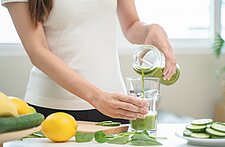Chef Cuadros was interviewed by Emmanuel Laroche, Symrise’s Senior Vice President, Marketing & Communications, Global Marketing Leader. Chef Cuadros is known for the Latin-inspired dishes which he creates at Carnivale, located in Chicago’s West Loop. Growing up in Cali, Colombia, young Rodolfo enjoyed helping his mother and his aunts in their busy kitchens, assisting them as they prepared traditional favorites for holiday celebrations. Years later, he earned a Culinary degree from Johnson and Wales University, and went on to delight diners at restaurants in worldwide locations. He is an expert in the nuances and ingredients of varied Latin American cuisine which he adapts to create unique Pan Latin dishes at Carnivale.
Emmanuel Laroche: Thanks so much for joining us. Let’s begin by learning something about your Hispanic heritage and its influence on your cooking today.
Rodolfo Cuadros: My family is originally from Colombia but I was born in New York. We returned to Colombia when I was two years old and I spent my first 10 to 12 years living there. I was greatly influenced during these formative years. We didn’t have McDonald’s and we didn’t have KFC. We did years later but in Colombia, it was just about once a year when we went to those fast food places. However, I did grow up watching my mother and my aunts getting together to cook for wonderful family dinners.
CLICK HERE to view a recap of Symrise Sabor in America at Carnivale Chicago
EL: How do you think your country is influencing the American food scene today?
RC: Hispanics are influencing America as the country’s largest minority. We demonstrate our culture in Latin restaurants and with all that you can see on television. Years ago no one knew what an arepa was. Cilantro was not familiar. No one ate, let alone prepared guacamole at home. Today, these are familiar to most people. Look at tamales - whether Nicaraguan, Mexican or Bolivian – they are a natural food for many – and have now become a comfort food. In the same way that other ethnic cuisine like Italian American, Irish American fare and West African food - which we know as soul food - have been adapted to mainstream consumption, so has Hispanic food arrived at America’s dining table.
CLICK HERE to view Culinary Chronicles, written by Symrise Chefs

EL: You cite cilantro as once being unfamiliar but now fully mainsteam, what other Latin American ingredients are likely to go mainstream?
RC: About 10 years ago, 90% of Americans did not know what a ceviche was. Today, perhaps more than 90% find it or its equivalent at American and even French and Italian restaurants. Many Hispanic entrees have been adapted into American culture. As far as ingredients, there are so many from countries in Central and South America and the Caribbean– it’s difficult to cite just one. Look at achiote - also known as annatto. It is a now being adapted by American chefs and accepted by American palates. It’s a tree nut, very earthy and fragrant, giving an unfamiliar depth of flavor. Cilantro continues to grow. I think people are less afraid of red onions than they once were. We use a lot of our different flours in our restaurants. Uncommon forms of polenta and grits and many corn flours are used. Then there are yucca – we’re just beginning to experiment with this amazing ingredient.
EL: How do you use and experiment with yucca?
RC: Well, yucca has great texture. Not many would think of using it as a puree but I have made many. It’s tricky since yucca has high starch content and can become gummy. But when you get it right, it is so rich, so earthy and flavorful and can really change a dish. I’ve had fun experimenting with yucca - like yucca charcoal - which looks like burnt yucca but is really nice, crispy and flavorful and can be eaten as chips in place of potato chips. When people try yucca chips for the first time, they really enjoy the taste.
CLICK HERE for more chef interviews in the weekly in-sight newsletter!
EL: Getting back to cilantro, is it similar to the different types of basil or thyme or is cilantro limited to just one variety?
RC: There is plenty of variety in cilantros. We mostly see the garden variety but there are many different types. There’s a cilantro used in Cuban and Puerto Rican food known as culantro. It has long flat leaves and tastes like cilantro but has 10 times the intensity. It is very, very strong. The leaf doesn’t break down like cilantro because it has a texture that resembles a light kale. Every herb that we use in our kitchen has hundreds of
relatives. One of my Ecuadorian cooks at the restaurant often speaks of the different herbs that he used in his native cuisine. These herbs usually grow wild so you can never really find them in the U.S. When you go to Ecuador or Peru, you find flavors that are difficult to get here. Speaking of Ecuadorian cuisine, chocolate is a wonderful ingredient from that country and considered to be one of the best chocolates in the world. Chocolate is widely used in Mexican food as well as other Latin American countries.
Be sure to check back tomorrow for part 2 of Chef Cuadros' Interview!




